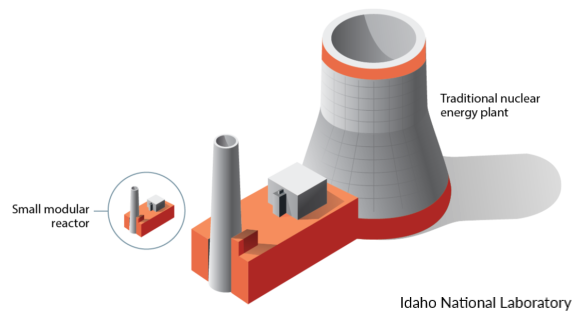As we watch the window of opportunity drop closer toward closing in the fight against climate change, humans must accelerate their race to find more clean energy sources for a power-hungry world.
 Is there a place in that strategy for emerging nuclear technologies? Some say yes, and have big hopes for "small modular nuclear reactors."
Is there a place in that strategy for emerging nuclear technologies? Some say yes, and have big hopes for "small modular nuclear reactors."
In just a few days - by May 16 - Duke Energy must submit its carbon emission reduction plan to the N.C. Utilities Commission. We're watching the process closely to see whether the utility will turn to unproven, potentially risky small modular nuclear reactors (SMRs) or rely on clean, practical energy sources like solar and wind to win the commission's approval for its carbon-cutting strategy.
A SMR is a technology defined by the International Atomic Energy Agency as a nuclear reactor under 300 MWe ("megawatt electrical," a unit of electric power used in the power industry). Globally, only one is in operation (in Russia) while others are being built or going through licensing processes, including in the United States.
In theory, SMRs could be manufactured, shipped, and installed more rapidly than large nuclear reactors, and could be more easily sited in already developed sites such as old coal plants, and in areas with smaller grid capacity. Proponents say they will be efficient, sustainable, relatively safe (compared to large reactors), and accessible energy sources that will bridge the gap to a clean energy future.
But SMRs would still create dangerous and difficult-to-store radioactive waste that, even in small amounts, could be subject to leaks or other accidents that jeopardize the environment and public health.
Excitement about the potential for SMRs has gained traction federally, although the technology has yet to be technically proven. In 2012, the U.S. Department of Energy (DOE) established a SMR Licensing Technical Support program that seeks to accelerate development of SMRs; it has since added a research and development program. In January 2021, the Biden administration issued an executive order to promote SMRs and other advanced reactor technologies with a focus on use at national defense operations.
The U.S. government is partnered with NuScale Power on a SMR demonstration project. NuScale’s design is the first and, so far, only SMR design to be approved by the U.S. Nuclear Regulatory Commission (NRC). Other countries are investing with NuScale as well; however, there are currently only around 50 SMRs in development across the globe. Overall, development has been slow and large-scale operationalization is years away.
What does this mean for North Carolina?
Duke Energy, North Carolina’s primary electric utility, is required to regularly submit Integrated Resource Plans (IRPs) to the N.C. Utilities Commission - its "road maps" for meeting future energy needs. Since Duke Energy operates as two companies in the state, Duke Energy Carolinas and Duke Energy Progress, it presents two IRPs.
The IRP drafting and approval process is intended to identify electric resource options that can be obtained by the utility at lowest cost to its ratepayers, consistent with adequate, reliable electric service. IRPs normally consider factors including energy efficiency, load management, weather, and what energy sources will be used - solar, wind, coal, gas, nuclear or other. IRPs generally have to show environmental compliance, affordability and reliability in order to win the Utilities Commission's approval.
Duke Energy’s 2020 IRP assumed that SMRs would be available to help meet future demand. The company appears to be counting on SMR technology to rapidly advance and contribute to its plans to meet its targets for cutting carbon emissions as req uired by law.
But are SMRs truly necessary - or even feasible - to reach a clean future? Or should North Carolina and Duke Energy rely on proven technologies such as wind and solar?
The nuclear power industry is notorious for being unpredictable and costly. For example, South Carolina’s failed V.C. Sumner project left utility customers holding a bill in the billions of dollars when the project was scrapped.
In its IRP, Duke Energy acknowledges that "uncertainty in the project cost and timeline [for an SMR] is another factor that will need to be understood before embarking on a groundbreaking project of this magnitude."
While fully operable SMRs are years away, solar and wind energy production have become increasingly cost-effective and reliable, with a demonstrated history of safety, efficiency, and sustainable growth.
From 2010 to 2020, the cost of utility-scale solar fell by 85 percent, onshore wind by 56 percent, and offshore wind by 48 percent. As of 2020, the majority of clean energy generation added to the grid was less expensive than the cheapest new fossil fuel.
These prices continue to fall at an accelerating rate. With ongoing improvements in battery storage capacity, solar and wind are proving to be solid, resilient, affordable and carbon-free energy production options.
The N.C. Sierra Club supports an energy transition away from fossil fuels to clean energy. New technologies may offer exciting opportunities to address climate change. But they can also derail us from clean energy goals if funding and attention is redirected to risky ideas that don’t pan out. We believe in an energy planning approach that allows for continuing research while staying on track with investment in proven successful options.